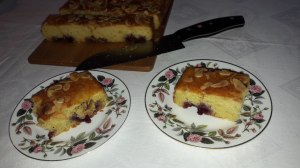In the first year of writing this blog, I wrote a post – Poles love to eat cabbage and now as I am writing about soups I am going to write about a Polish classic – kapuśniak – cabbage soup.
There are two types – ones made with fresh cabbage (written about in my previous post) and ones made with sauerkraut.
Now I am going to write about ones made with sauerkraut and these are certainly soups that have the sour taste loved by Poles.
As half a large jar is enough for each of the soups, I often freeze the other half of the sauerkraut to use at a later date.
Kapuśniak – Version 1
Ingredients
- 400g sauerkraut
- 200g smoked Polish sausage
- 1.5 – 2 litres of vegetable stock (can be from powder or cubes)
- 3-4 peppercorns
- 1 bay leaf
- 2 tablespoons of plain flour
- 1 large onion
- Oil for frying (originally pork fat/lard would have been used)
- Salt & Pepper to taste
- 1 tablespoon of granulated sugar
- **
- More sugar & lemon juice to adjust the sourness might be needed at the end.
Method
- Chop the sauerkraut into shorter strands.
- Chop the sausage into small pieces.
- Into a large pot of vegetable stock add the sauerkraut, sausage, peppercorns and bay leaf
- Bring to the boil, then cover the pan and allow it to simmer until the sauerkraut is tender.
- Chop the onion into small pieces and fry up till nearly charred.
- Stir in the flour and heat till well browned.
- Add a couple of tablespoons of soup liquid and stir to get a thick roux.
- Add this onion mixture to the soup, mixing it in well.
- Add the sugar.
- Add salt and pepper if necessary.
- You might want to adjust the sourness which will depend on the sauerkraut used.
- I rarely add more lemon juice but sometimes add a bit more sugar.
- The soup is supposed to be a little sour!
Served here in Royal Doulton – Burgundy -1959 to 1981
Kapuśniak – Version 2
Ingredients
- 400g sauerkraut
- 1 onion chopped
- 100g chopped smoked bacon
- 2 litres of vegetable stock
- 1 bay leaf
- 3-4 peppercorns
- 2 large potatoes
- 1/2 teaspoon of caraway seeds
- 1 – 2 tablespoons of granulated sugar
- Salt & Pepper to taste
- **
- More sugar & lemon juice to adjust the sourness might be needed at the end.
Method
- Chop the sauerkraut into shorter strands.
- Chop the bacon into small pieces.
- Chop the onion into small pieces
- Into a large pot of vegetable stock add the sauerkraut, sausage, peppercorns and bay leaf
- Bring to the boil, then cover the pan and allow it to simmer until the sauerkraut is tender.
- Add the caraway seeds.
- Chop the potatoes into small to medium chunks.
- Add the potatoes to the cooked sauerkraut and simmer gently till cooked.
- Add the sugar.
- Add salt and pepper if necessary.
- You might want to adjust the sourness which will depend on the sauerkraut used.
- I rarely add more lemon juice but sometimes add a bit more sugar.
- The soup is supposed to be a little sour!
Served here in Royal Doulton – Tapestry -1966 to 1988





































































































































